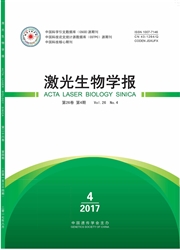

 中文摘要:
中文摘要:
细胞凋亡是机体生命活动中重要的细胞学事件,在许多疾病的治疗中也起着关键性的作用.在多种凋亡因子刺激下,Bax的构象发生改变,寡聚化,插入线粒体外膜上.虽然关于Bax蛋白的研究已经取得了很大进展,但是Bax蛋白是如何转位到线粒体以及如何引起细胞色C释放等许多问题尚未十分清楚.为了进一步对Bax蛋白的生物学行为进行研究,特别是在无损伤、活细胞生理条件下,本实验采用了荧光蛋白标记和荧光成像技术对PDT作用凋亡过程中Bax蛋白在活细胞内分布的动态过程进行了初步研究.结果表明:在没有PDT作用时,Bax蛋白比较均匀地分布在整个细胞内,而PDT处理15分钟后,Bax蛋白开始不均匀分布在整个细胞,定位在线粒体上.该研究为今后使用荧光蛋白标记的方法在无损伤、活细胞生理条件下研究Bax蛋白定位机理以及如何诱导细胞色素C释放等问题打下了坚实的基础.
 英文摘要:
英文摘要:
Apoptosis is an important cellular event that plays a key role in pathogeny and therapy of many diseases. Upon stimulation by various apoptotic inducers, Bax undergoes conformational changes, oligomerization, translocation from cytosol to mitochondria. Despite recent progress in the study of Bax during apoptosis , it remains unclear how Bax translocates to mitochondria and then induces the release of cytochrome c and other substances. In order to further study the biological action of Bax during apoptosis , especially under physiological condition of living cell , the distribution of Bax in single living cell during photodynamic therapy-induced apoptosis was primarily investigated by the use of fluorescence microscopy. The results showed that Bax equally distributed in cells without PDT treatment, thus the activation of Bax started 15 minutes after PDT treatment. This study suggests that it is possible to use fluorescence techniques to dynamically detect the mechanisms of Bax translocation and oligomerization in living cells.
 同期刊论文项目
同期刊论文项目
 同项目期刊论文
同项目期刊论文
 期刊信息
期刊信息
